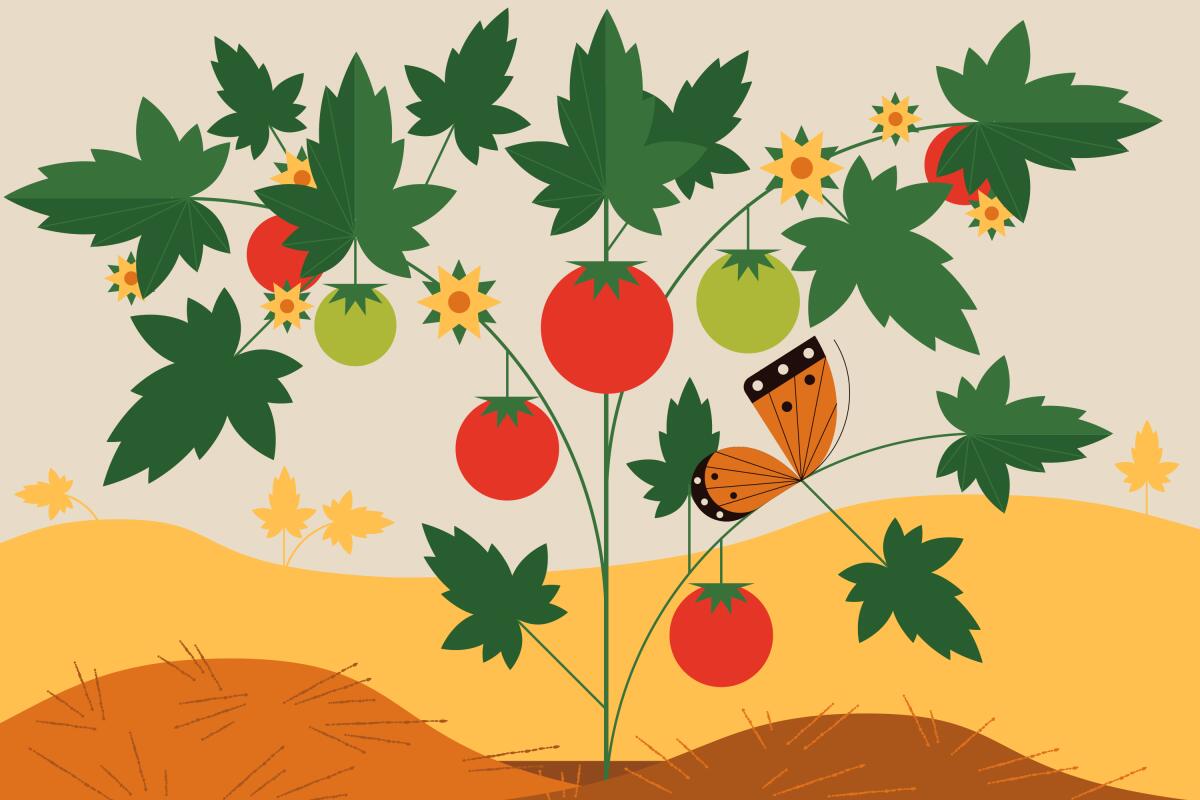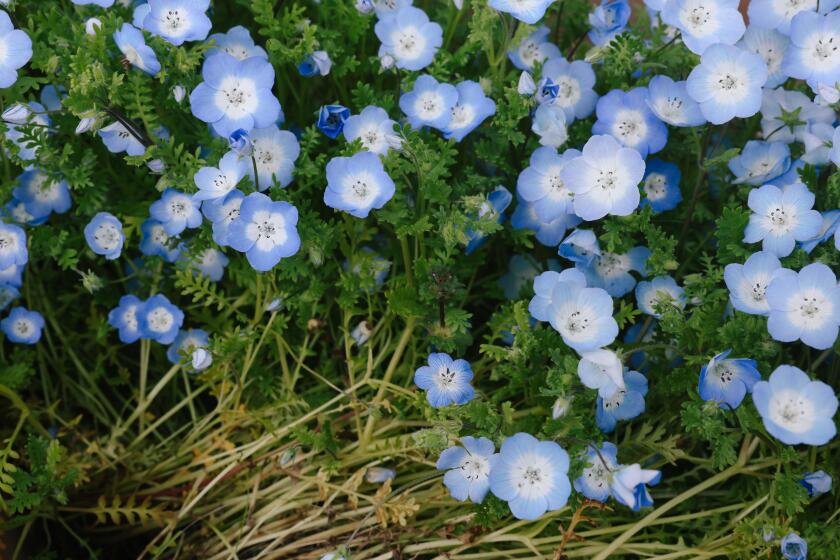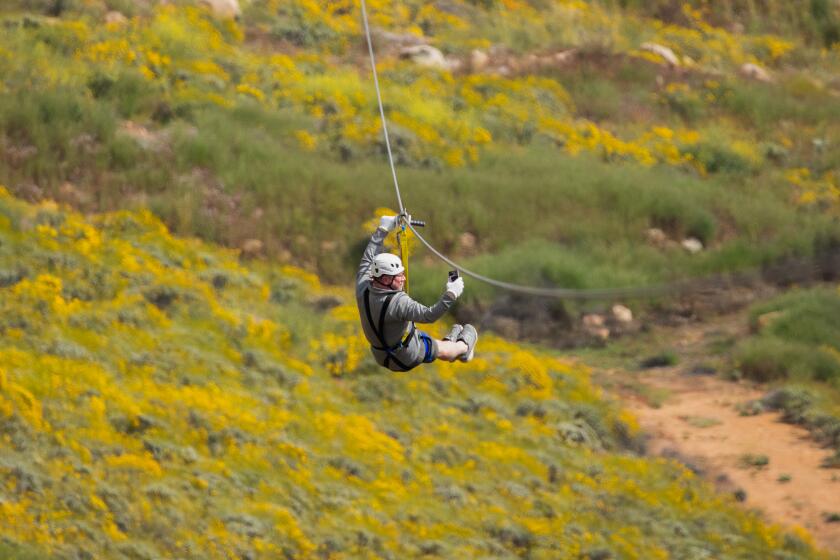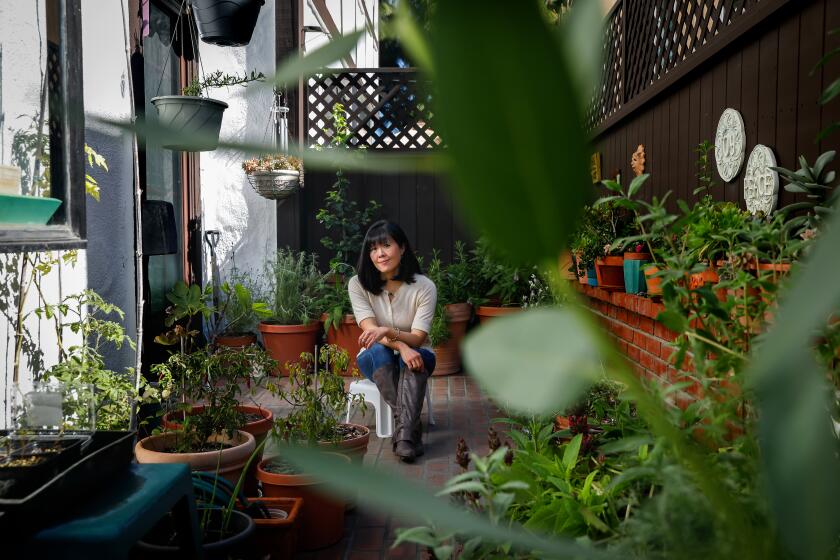How to grow juicy tomatoes this summer, not powdery mildew and fungus

- Share via
Nothing says sunshine like a warm, ripe tomato and after our long wet winter, we’re all eager for as much delicious “sunshine” as we can plant.
But take care with how you plant tomatoes this year, because all that wonderful water in our thirsty ground has also made our gardens more susceptible to fungal diseases, which can turn your crop into a sad, withered mess of mildewed leaves and zero tasty fruits.
“That’s just how it goes — the more water in the soil, the more fungal disease we get,” said Scott Daigre, the tomato-growing expert who owns and operates Tomatomania, which offers more than 100 varieties of tomatoes and peppers to growers every year at various pop-up sites around Southern California.
Prisk Native Garden’s fragrant blooms usually are inaccessible to the public, but this spring you have two chances to visit during SoCal’s many spring garden tours.
Those sales started in late February, when we were still getting heaps of rain, and mostly ended in April, but some of Tomatomania’s many varieties should be available through May at Underwood Family Farms in Moorpark and Somis and Wachter’s Hay & Grain in Ojai. You can also find a big selection of tomatoes and pepper plants at Cal Poly Pomona’s Farm Store Nursery.
Many people probably delayed planting their tomatoes because of the wet, cool conditions, Daigre said, but now that things are heating up, he recommends that even inland SoCal gardeners approach their tomato growing the way people do on the coast, where conditions are usually cooler and fungal diseases like powdery mildew are more rampant.
Bottom line: You’ll need to be more hands-on in the garden this year to keep fungal diseases at bay, Daigre said. Here are his basic tips:
- Give your tomatoes space. Plant them at least three to six feet apart, so they can get plenty of air and sun. Crowding reduces sunlight to the plants and encourages the spread of disease and dreaded spider mites. Also note that spider mites, another garden blight, prefer dark, dry conditions, so the more air and space you create around your tomatoes, the less likely you are to suffer problems from those pests.
- Trim the bottom leaves. Fungus spores live in the soil, so it’s particularly important this year to keep leaves from touching the ground. Trim the leaves several inches up the stem, and be careful when you water, since splashing can transfer the fungal spores from the soil to the leaves.
- Mulch, mulch, mulch! “People use everything from cardboard to canvas to straw ... it’s just a good idea to protect the moisture in the soil and block potential fungal spores,” Daigre said.
- Remove side branches and keep pinching new shoots. “Tomato plants have just X amount of energy,” Daigre said, so the more branches you allow on the plant, the denser the foliage and the less energy available for producing fruit. A jungle of leaves also makes it hard for the plant to get sun and easier for diseases to spread, so he recommends using a method common in greenhouses — focus on a single stem for your plant by removing side branches and pinching off the new shoots that grow between the stems and leaves at least once a week. “Every side branch will flower and has potential for fruit, but because of the energy quotient, the fruit will be a lot smaller,” he said. “If you want to win the biggest tomato competition at the fair, you’re going to be pinching branches and flowers ... but that’s a lot of work. I’m a firm believer in pinching a little bit, at least, to make sure the sun is hitting all those leaves. Otherwise, it turns into a jungle in there.”
- Make new plants with your trimmings! The good news is that you can root a 6-8-inch branch and plant it for an additional crop, Daigre said. “Don’t pick a wimpy branch, pick the strong one, put it into a glass of water until it roots and then plant it. You’ll be literally extending your season.”
Here are the best retail native plant nurseries in Southern California to help you create a habitat for birds and pollinators in your yard or even on a patio.
And heaven knows, we love to eat fresh, ripe tomatoes as long as we can, especially if we can get them for free!
We’re running full speed into summer now that it’s May. For a list of other plant-related activities and events this month, see below. One note, however: We’re starting a newsletter soon that will deliver a calendar of plant-related events to your inbox once a month. If you’re interested, sign up here. And if you have an event you’d like to include in the calendar, email the information to [email protected] by the third week of the month before the event is scheduled, and we may include it. Happy gardening!
May 3
Reimagining Landscape + Lifestyle, a First Wednesdays lecture from 7-9 p.m. at the Aquarium of the Pacific, 100 Aquarium Way in Long Beach, features Leigh Adams and Shawn Maestretti, owners of the regenerative landscape design firm Studio Petrichor, discussing how conscious landscape design can “rehabilitate the land, support biodiversity and empower people.” Tickets are $5 with advance online reservations or $10 at the door, if space is available. Parking is $6. aquariumofpacific.org
May 6
Bromeliad Society of La Ballona Valley Annual Bromeliad Show & Plant Sale, 10 a.m to 5 p.m. at the Culver City Veterans Complex Multipurpose Room, 4117 Overland Ave. The event will feature exhibits of at least 20 varieties of bromeliads, many of which are known as air plants. Members and vendors will also be selling many types of bromeliads. Admission is free. bsi.org/webpages/lbvbs/
Plants.Choto Greenhouse Open House, 10 a.m. to 3 p.m. at 1121 W. Fiat St. in Torrance features a wide selection of tropical plants, cuttings, seedlings and mother plants as well as snacks and drawings for free plants. Admission is free, but advance registration is required. eventbrite.com
Skull Canyon Ziplines in Corona lets superbloom lovers soar over poppy fields and bush sunflowers without fear of damaging the wildflowers.
Bugs for Plant Nerds, a workshop for teens and adults by Bob “BugBob” Allen, co-author of “Wildflowers of Orange County and the Santa Ana Mountains,” 9:30 to 11:30 a.m. at the Tree of Life Nursery, 33201 Ortega Highway in San Juan Capistrano. Tickets are $20 and advance registration is required. californianativeplants.com
May 6, 13, 20, 27
L.A. County Public Works’ Smart Gardening workshops for beginners teach the basic techniques of backyard composting, worm composting, water-wise gardening, grasscycling (leaving grass clippings on a lawn to act as fertilizer) and edible gardening. The workshops are free, and scheduled at various communities in the county, typically from 10 to 11:30 a.m. unless otherwise noted — on May 6 at Arroyo Seco Library, 6145 N. Figueroa St., Highland Park; May 13 at La Verne Library, 3640 D St., from 11:30 a.m. to 1 p.m.; May 20 at Eaton Canyon Nature Center, 1750 N. Altadena Drive in Pasadena, and May 27 at Pico Rivera Library, 9001 Mines Ave. Participants can also purchase compost bins at the workshops for $40 and worm compost bins for $65. pw.lacounty.gov
May 8
Compton Community Garden Volunteer Day, 9:30 a.m. to 1 p.m. at 1317 S. Long Beach Blvd. in Compton. This is an event organized by the USAL Project to help prepare and plant seedlings at the organic, regenerative garden whose mission is to provide healthy food to the communities of Compton and North Long Beach. Volunteers should register online — participation costs $5 — and bring work boots, drinking water, gloves and handheld gardening tools. Proceeds from the tickets will go to supporting the garden. usalproject.com
May 10
Cork-Mounted Plants Workshop, 7-8:30 p.m. at Folia Collective, 5052 Eagle Rock Blvd. in Eagle Rock. Learn how to mount plants on cork with “Folia’s mounted plant guy” Bill Horst. Tickets are $40 and include mounting supplies and one plant. Register online. foliacollective.com
May 12-13
The Gates Cactus and Succulent Society of the Inland Empire 48th Cactus and Succulent Show and Sale, 9 a.m. to 4 p.m. both days at the Redlands Church of the Nazarene, 1307 E. Citrus Ave. in Redlands. The club is resuming the show that was canceled during the pandemic. The event will include displays of many rare and unusual succulents, including aloe, echeveria, euphorbia, agave, opuntia, pachypodium and ferocactus. Vendors will be selling a variety of plants, as well as pottery, garden decor and decorative rocks. Admission is free. gatescactusandsucculentsociety.com
May 13
City of Santa Monica Main Street Community Garden Open House, 9-11 a.m. at 2318 Main St. Learn more about the garden and community gardeners. Admission is free. santamonica.gov/events
Barbara Chung fell in love with native plants, but she didn’t have a yard. So she created a habitat garden in pots on her tiny townhouse patio in Santa Monica.
May 13, 20 & June 3
Carbon Culture Hands-On Hugelkultur Workshops, 8:30 a.m. to 12:30 p.m. each day in Pasadena, at a site to be announced to registrants. Studio Petrichor, a regenerative garden design firm specializing in native plant landscapes, is offering three separate workshops for people who want to learn hugelkultur techniques that use logs and wood chips to create contours in a yard and help conserve moisture and build soil health. The individual workshops are $40, with lunch included. People interested in earning Studio Petrichor’s Hugelist Certification Program must attend all three workshops, assist for a couple of hours in gathering materials and participate in two online Zoom workshops prior to the first hands-on workshop and after the last. The certification program is $200 plus the cost of the three workshops. studio-petrichor.com
May 20
The City of Ventura presents Pollinator Palooza, a family-friendly event to learn about bees, birds, butterflies and other pollinators from 10 a.m. to 2 p.m. at Barranca Vista Park, 7050 Ralston St. in Ventura. Master gardener Laura Pasetta will discuss pollinating insects at 11:30 a.m. and members of the Cornucopia Community Garden will conduct tours of the garden and offer tips for creating a pollinator-friendly garden. Other activities include making beeswax candles and seed bombs and painting bee boxes. Admission is free. cityofventura.ca.gov
City of Santa Monica Garden Bingo, 9 to 11 a.m. at Ishihara Park Learning Garden, 2909 Exposition Blvd. Children can fill a bingo card by looking for items in the garden while adults can attend mini workshops on composting, seed starting and other garden topics. Participants can plant a six-pack of vegetable seeds to grow at home, for a seedling giveaway later in June (date has not been announced). Admission is free. santamonica.gov/events
May 21
South Coast Cactus & Succulent Society features author and succulent expert Duke Benandon discussing the plants and animals he encountered traveling in Baja California, 1 p.m. at 26300 Crenshaw Blvd. in Rolling Hills Estates. Admission is free. southcoastcss.org
California native plants have many pros, but their potent scents are the biggest draw of all. Gardening experts share the most fragrant native plants.
May 27
Spring and Summer Planting Tips features master gardener Yvonne Savio, creator of GardeninginLA.net, discussing the many edible and ornamental plants that thrive in Southern California’s warmest season. 3:30-4:30 p.m. at the Culver City Julian Dixon Library, 4975 Overland Ave. Admission is free but advance registration is required. visit.lacountylibrary.org
Fragrant Plants for your Garden features Laura Bauer, assistant manager of Growing Works Nursery, discussing California native plants and other plants that will fill your garden with delicious scents all year round, 10:30 a.m. at the nursery, 1736 S. Lewis Road in Camarillo. The wholesale nursery, which specializes in native plants and succulents, will also be open for retail sales on May 27 from 10 a.m. to 2 p.m. turningpointfoundation.org
More to Read
Sign up for The Wild
We’ll help you find the best places to hike, bike and run, as well as the perfect silent spots for meditation and yoga.
You may occasionally receive promotional content from the Los Angeles Times.
















